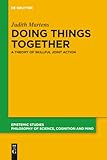Doing Things Together : A Theory of Skillful Joint Action / Judith Martens.
Material type: TextSeries: Epistemic Studies : Philosophy of Science, Cognition and Mind ; 41Publisher: Berlin ; Boston : De Gruyter, [2020]Copyright date: ©2020Description: 1 online resource (IX, 208 p.)Content type:
TextSeries: Epistemic Studies : Philosophy of Science, Cognition and Mind ; 41Publisher: Berlin ; Boston : De Gruyter, [2020]Copyright date: ©2020Description: 1 online resource (IX, 208 p.)Content type: - 9783110670172
- 9783110671339
- 9783110671315
- online - DeGruyter
- Issued also in print.
| Item type | Current library | Call number | URL | Status | Notes | Barcode | |
|---|---|---|---|---|---|---|---|
 eBook
eBook
|
Biblioteca "Angelicum" Pont. Univ. S.Tommaso d'Aquino Nuvola online | online - DeGruyter (Browse shelf(Opens below)) | Online access | Not for loan (Accesso limitato) | Accesso per gli utenti autorizzati / Access for authorized users | (dgr)9783110671315 |
Diss. Ruhr Universität Bochum 2018.
Frontmatter -- Contents -- 1. Introduction: A Multidimensional Understanding of Acting Together -- 2. The Automatic/Non-Automatic Divide -- 3. Control and Intentions in Individuals -- 4. Motor Control and Skillful Action -- 5. Planning Agency and Shared Agency -- 6. Joint Action and Interaction -- 7. Skillful Joint Action -- References -- Subject Index -- Index of Names
restricted access online access with authorization star
http://purl.org/coar/access_right/c_16ec
To understand many of our everyday joint actions we need a theory of skillful joint action. In everyday contexts we do numerous things together. Philosophers of collective intentionality have wondered how we can distinguish parallel cases from cases where we act together. Often their theories argue in favor of one characteristic, feature, or function, that differentiates the two. This feature then distinguishes parallel actions from joint action. The approach in this book is different. Three claims are developed: (1) There are several functions that help human agents coordinate and act together. (2) This entails that joint action should be understood through these different, interrelated, types of coordination. (3) A multidimensional conceptual space, with three levels of control and coordination, will allow us to connect these different forms of coordination and their interdependencies. This allows us to understand the jointness of an action in a more differentiated and encompassing way. This approach has ramifications for several distinctions that are typically understood to be binary, including those between action and mere bodily movement, joint action and parallel action, and action together and not together.
Issued also in print.
Mode of access: Internet via World Wide Web.
In English.
Description based on online resource; title from PDF title page (publisher's Web site, viewed 28. Feb 2023)


